
2 Techniques for Counting
$$
$$
To apply the classical definition of probability, we need to count the number of outcomes in the sample space and in the event of interest. For the examples in Chapter 1, we did so by explicitly listing out the relevant outcomes (e.g., see Figure 1.9). But in this chapter, we will encounter events and sample spaces so large that listing out every outcome is impractical. To tackle these more difficult problems, we will need tools from combinatorics, the branch of mathematics concerned with counting.
Like probability, combinatorics is a tricky subject that can be daunting and counterintuitive at first. But once you learn a few basic principles, you will be able to tackle a wide variety of probability problems involving counting.
2.1 The Fundamental Principle of Counting
We open with a simple everyday example that illustrates the core idea behind counting.
In Example 2.1, we used the following principle.
In Example 2.1, we made outfits by performing three actions: choosing a pair of shoes, choosing a pair of pants, and choosing a shirt. Each way of performing the actions results in a unique outfit, and each possible outfit results from a unique way of performing the actions. Consequently, the number of possible outfits is equal to the number of unique ways to perform these actions. Since there are \(3\) ways to perform the first action, then always \(2\) ways to perform the second, and then always \(4\) ways to perform the third, Theorem 2.1 implies that there are \(2 \times 3 \times 4 = 24\) unique ways of performing the actions, and hence \(24\) possible outfits. Check for yourself that, even if the shoes, pants, and shirt had been picked in a different order (e.g., first pick the pants, then shirt, then shoes), we would have obtained the same answer.
2.2 Four Ways of Counting
Many counting problems in probability take the form of: “How many ways are there to pick \(k\) items from \(n\) (unique) items?” For example, consider a local ice cream shop that offers \(n=5\) flavors. They allow customers to pick \(k=3\) scoops. How many distinct ice cream “experiences” are there?

Unfortunately, this question is ambiguous as stated. First, it depends on whether or not order matters—that is, whether the ice cream is in a cone or a cup. In a cone, the experience depends on the order of the scoops; eating chocolate after mint is a different experience from eating mint after chocolate, and the cone is consumed with whichever flavor is on the bottom. In a cup, the order of the flavors does not affect the experience, since all scoops are equally accessible.

There is also the matter of whether the items are selected with or without replacement—that is, whether there can be multiple scoops of the same flavor. There will be more possible ice cream experiences if a flavor can be picked multiple times.
2.2.1 Order Matters: Ice Cream in a Cone
When scoops of ice cream are in a cone, the order of the scoops matters. \((\text{mint}, \text{chocolate}, \text{strawberry})\) is a distinct experience from \((\text{strawberry}, \text{chocolate}, \text{mint})\). How do we count the total number of distinct experiences?
2.2.1.1 Picking with Replacement
If we allow the possibility of picking the same flavor multiple times, then there are \(5\) options for the first scoop, \(5\) options again for the second scoop, and \(5\) options still for the last scoop. By the fundamental principle of counting (Theorem 2.1), the number of distinct experiences when selecting with replacement is \[ 5 \times 5 \times 5 = 5^3 = 125. \]
This is a special case of a more general rule.
Proposition 2.1 is especially handy in probability problems where the same action is repeated over and over, such as rolling a die multiple times. In the next example, we use Proposition 2.1 to correctly solve Example 1.1, a problem that Cardano himself solved incorrectly. Cardano had reasoned that it would take \(n=3\) rolls of a fair die to have an even chance of rolling a six.
2.2.1.2 Picking without Replacement
What if we do not allow the possibility of picking the same flavor multiple times? We can count the number of ways to pick three distinct flavors as follows: there are \(5\) options for the first scoop, \(4\) options for the second scoop (because it must be one of the other four flavors), and only \(3\) options for the last scoop. By the fundamental principle of counting (Theorem 2.1), the number of distinct experiences when selecting without replacement is \[ 5 \times 4 \times 3 = 60. \]
We can write this expression more compactly with the help of factorials. Recall that \(n!\) (pronounced “\(n\) factorial”) is defined to be the product of the integers from \(n\) down to \(1\): \[ n! = n \times (n-1) \times \dots \times 1. \] (By convention, \(0!\) is defined to be \(1\).) Using factorials, we can write \[ 5 \times 4 \times 3 = \frac{5!}{2!}. \]
The same reasoning extends to any ordered selection of \(k\) items from a collection of \(n\) unique items.
Proposition 2.2 can be used to count the number of ways of arranging \(n\) items. A particular arrangement or ordering of items is called a permutation of the items.
Corollary 2.1 can be applied to Secret Santa (Example 1.7).
The last example is a classic probability brainteaser with a surprising answer. It makes use of both Proposition 2.1 and Proposition 2.2.
2.2.2 Order Does Not Matter: Ice Cream in a Cup
When ice cream is in a cup, the order of the scoops does not matter. How many distinct ice cream experiences are there if the scoops are in a cup?
2.2.2.1 Picking without Replacement
First, we consider the case where the flavors are chosen without replacement; that is, when the scoops must be of different flavors. To count the number of distinct experiences, we will first count the number of ordered experiences and then adjust for double counting.
In Section 2.2.1, we showed that there were \(\frac{5!}{2!} = 60\) distinct experiences with a cone, when the scoops were required to be of different flavors. We list these \(60\) experiences in Figure 2.4. We arrange this list so that different reorderings of the same three flavors are in the same row.
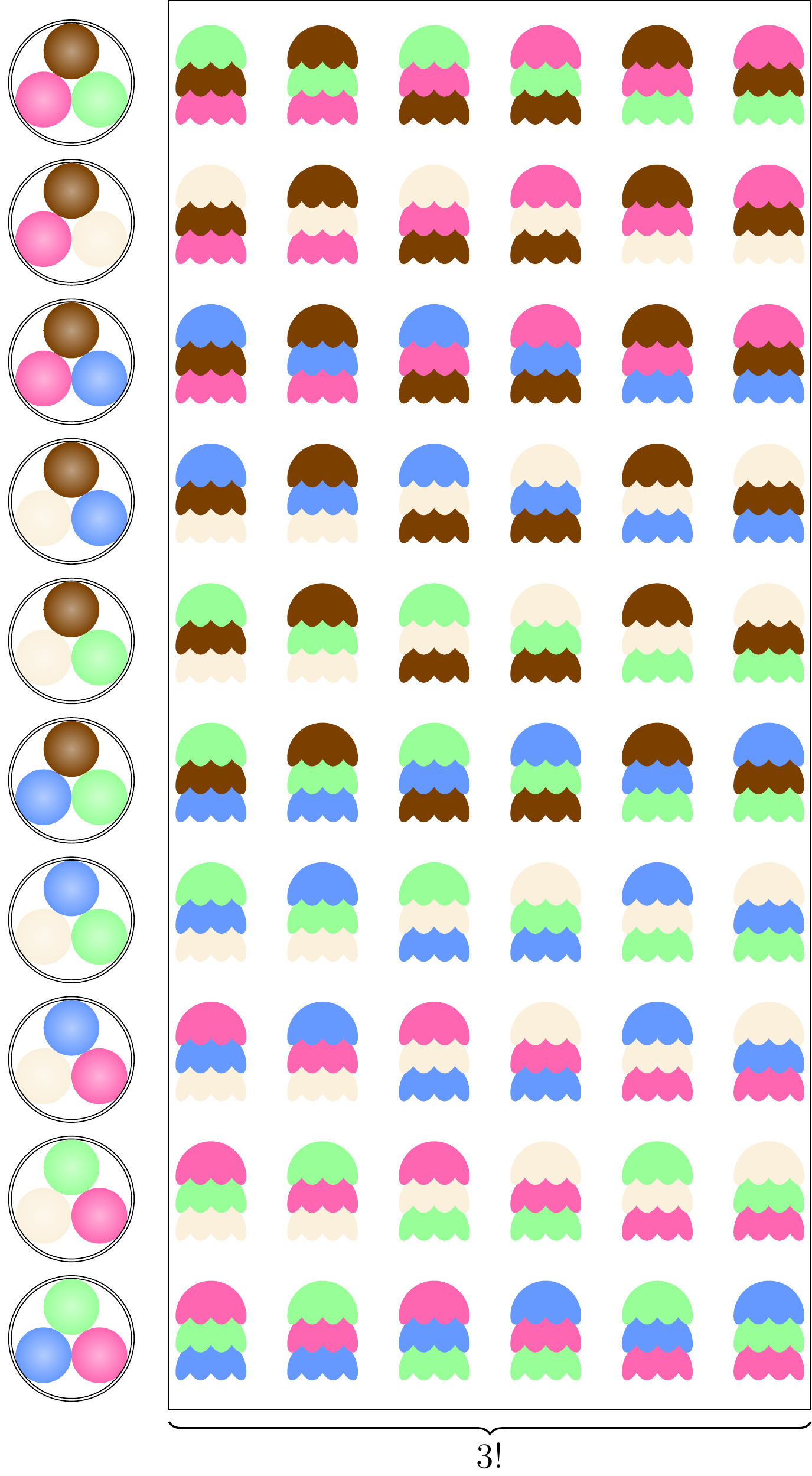
In Figure 2.4, we know that the rectangle contains \(\frac{5!}{2!} = 60\) distinct ordered experiences, by Proposition 2.2. However, we want to count the number of distinct unordered experiences, which corresponds to the number of rows in the rectangle. Since each row contains \(3! = 6\) ordered experiences (because there are \(3!\) ways to order the same three flavors), we can simply divide \(\frac{5!}{2!}\) by \(3!\) to obtain the number of rows: \[ \frac{5!}{3! 2!} = 10. \]
Generalizing this argument to any \(n\) and \(k\), we know that there are \(\frac{n!}{(n-k)!}\) ordered ways to select \(k\) items from \(n\) without replacement, but this double-counts each set of items \(k!\) times. Therefore, we divide by \(k!\) to obtain the number of unordered ways to select \(k\) items from \(n\).
One situation where it is natural to consider unordered outcomes is in the card game poker. In poker, each player is dealt a hand of five cards from a shuffled deck of playing cards, such as the one shown in Example 1.5. The player with the “best” hand wins. (In poker, the hands are ranked based on their probability; rarer hands are considered better. For a list of poker hands, please refer to this Wikipedia article.)
In the next example, we calculate the probability of a full house, one of the best hands in poker. Notice that the order of the five cards in the hand does not matter, which is why Proposition 2.3 applies.
We can also use Proposition 2.3 to address a common misconception about the frequentist interpretation of probability introduced in Chapter 1. To say that a coin has a \(0.5\) probability of landing heads means that if we were to toss the coin \(n\) times, then the proportion of heads will approach \(0.5\) as \(n\) grows. It does not mean that the number of heads will approach \(0.5 \cdot n\), as the next example shows.
2.2.2.2 Picking with Replacement
What if the flavors had been selected with replacement? That is, what if we allow multiple scoops of the same flavor? Clearly, there would be more ice cream cup experiences than the \(\binom{5}{3} = 10\) experiences above. We also have to count the possibility of two scoops of strawberry and one scoop of chocolate, or even the possibility of three scoops of mint, as illustrated in Figure 2.5. These scoops are in a cup, so order still does not matter.

Counting the number of distinct experiences requires a touch of ingenuity. First, when order does not matter, each experience can be summarized by reporting the number of scoops of each flavor. We can create \(5\) bins, one for each flavor, using \(4\) “bars,” as shown below: \[ \phantom{*}\underbrace{}_{\text{vanilla}} \big| \phantom{*}\underbrace{}_{\text{chocolate}} \big| \phantom{*}\underbrace{}_{\text{strawberry}} \big| \phantom{*}\underbrace{}_{\text{blueberry}} \big| \phantom{*}\underbrace{}_{\text{mint}}. \] Next, we will represent each scoop by a “star.” For a cup with \(3\) scoops, there will be \(3\) stars. For example, the two cups in Figure 2.5 would be represented by the pictures \[ \begin{align} \big|\ *\ \big| * *\ \big|\ \big| & & \text{and} & & \big|\ \big| \ \big|\ \big|\ * * *. \end{align} \] Now, the question is how many possible “stars and bars” pictures can we draw, consisting of \(3\) stars and \(4\) bars? Since there are \(7\) total objects, and we need to choose the positions of the \(3\) stars, there are \[ \binom{7}{3} = \frac{7!}{3! 4!} = 35 \] distinct cup experiences if we can have multiple scoops of the same flavor. Equivalently, we could have chosen the positions of the \(4\) bars and obtained the same answer: \[ \binom{7}{4} = \frac{7!}{4! 3!} = 35. \] The fact that these two binomial coefficients have the same value is no accident, as you will show in Exercise 2.18.
We can use the same “stars and bars” argument for any \(n\) and \(k\). If there are \(n\) flavors, then there will be \(n-1\) bars and \(k+n-1\) total objects to arrange.
However, Proposition 2.4 is less useful than Proposition 2.3 in probability theory. This is because unordered outcomes are usually not equally likely when items are selected with replacement. Leibniz’s mistake in Example 1.2 essentially arose from trying to use Proposition 2.4 to calculate probabilities.
2.2.3 Summary
How many ways are there to pick \(k\) items from \(n\) (unique) items? The answer to this question depends on
- whether order matters or not, and
- whether items are selected with or without replacement.
In this section, we determined the answer to all four cases, and the formulas are summarized in Table 2.1.
| Order Matters | Order Does Not Matter | |
|---|---|---|
| Without Replacement | \(\displaystyle\frac{n!}{(n-k)!}\) | \(\displaystyle {n \choose k}\) |
| With Replacement | \(\displaystyle n^k\) | \(\displaystyle {k+n-1 \choose k}\) |
2.3 Combinatorial Identities
In this section, we will state a few important identities from combinatorics and prove them. Not only will these identities be useful in later chapters, but the proofs serve as further examples of the counting techniques introduced above.
For each of the identities below, we will demonstrate two proof strategies:
- algebra, by manipulating the expressions on both sides
- counting in two ways, by regarding the expressions on both sides as counting the same quantity in different ways.
Although algebraic proofs are straightforward, they can be messy. By contrast, proofs based on counting in two ways often require inspiration, but usually end up being simpler and more memorable. For example, the next identity can be difficult to remember, but its proof can actually serve as a mnemonic.
Proposition 2.5 is useful, and we will use this identity later in Proposition 9.2.
The next identity is historically significant, as it was discovered by Blaise Pascal while working on the problem of points (Example 1.10). It is also central to the theory of binomial coefficients, as we will see.
Pascal used Proposition 2.6 to calculate binomial coefficients, which are necessary to determine the probability of winning in the problem of points (see Exercise 2.17). Pascal first noted that \({n \choose 0} = {n \choose n} = 1\) and calculated other binomial coefficients by repeatedly applying Proposition 2.6.
For example, \[ {2 \choose 1} = {1 \choose 1} + {1 \choose 0} = 2 \] and \[ {3 \choose 2} = {2 \choose 2} + {2 \choose 1} = 3. \] Pascal organized these numbers into the table shown in Figure 2.6, which has come to be known as Pascal’s triangle.
However, the modern Pascal’s triangle is drawn a bit differently, as illustrated in Figure 2.7. Each row contains the binomial coefficients \(n \choose k\) for \(k=0, 1, \dots, n\). For example, the circled value in Figure 2.7 corresponds to \({3 \choose 2}\).
Furthermore, each value can be obtained by adding the two values from the previous row. But this is just Equation 2.5 in words!
Pascal was not the first person to discover the triangle that now bears his name—at least in the Western world. The Persian poet Omar Khayyam (1048-1131) popularized the triangle, and it is still known as “Khayyam’s triangle” (مثلث خیام) in Iran today.
Figure 2.8 shows the triangle as it appeared in a Chinese mathematics text from 1303, Jade Mirror of the Four Unknowns (四元玉鑒). In the Chinese-speaking world, the triangle is known as “Yang Hui’s triangle” (杨辉三角) after the mathematician Yang Hui (1238-1298).
Pascal was not even the first European to discover the triangle, as it had appeared earlier in the works of Cardano. Thus, “Pascal’s triangle” is an example of “Stigler’s Law of Eponymy” (named for the statistician Stephen Stigler), which states that no scientific discovery is named after its original discoverer.
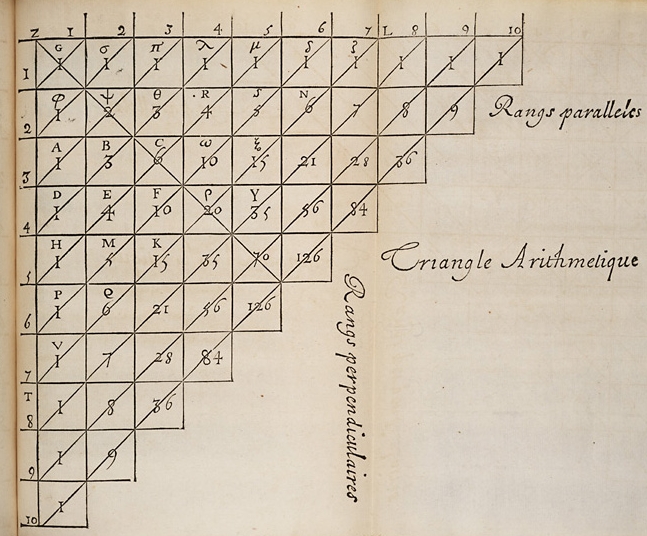
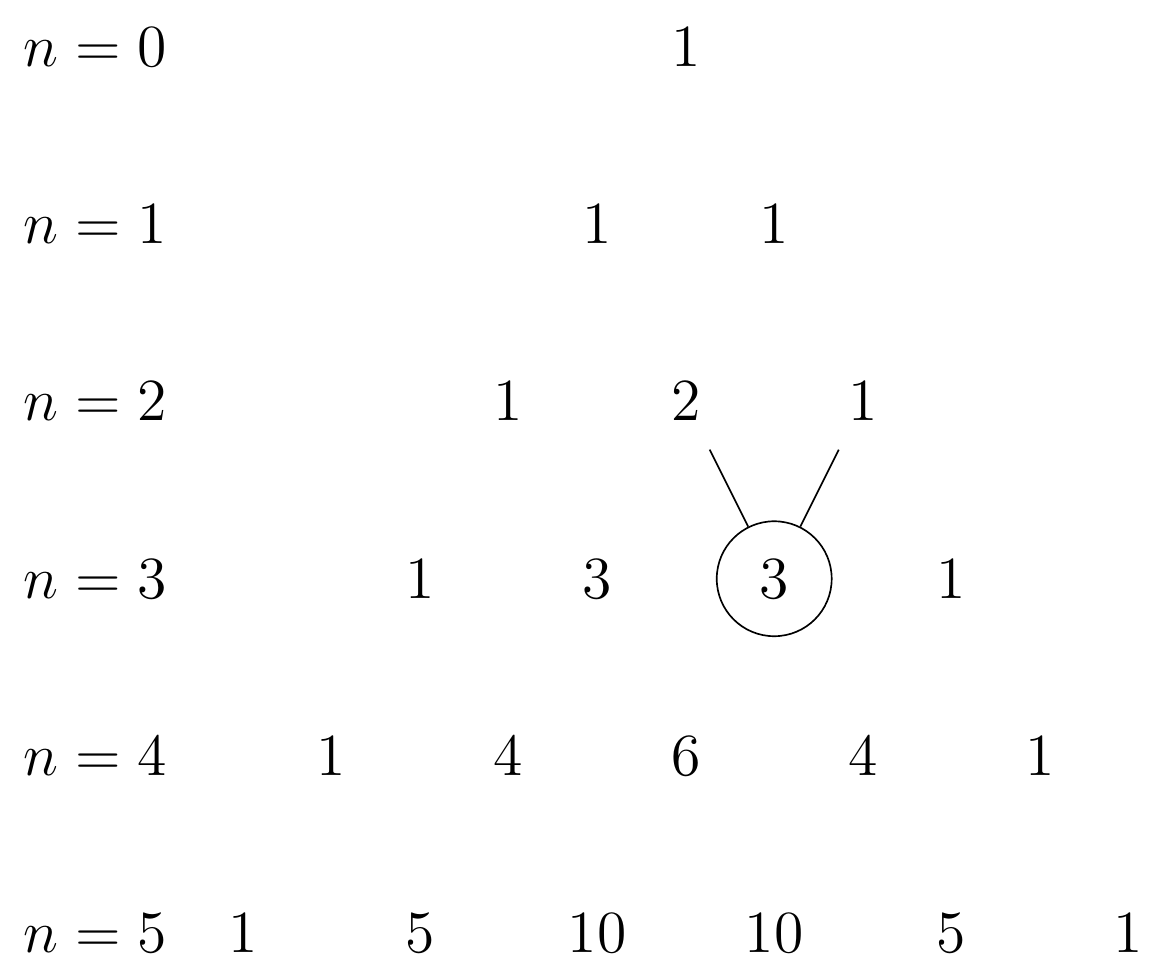
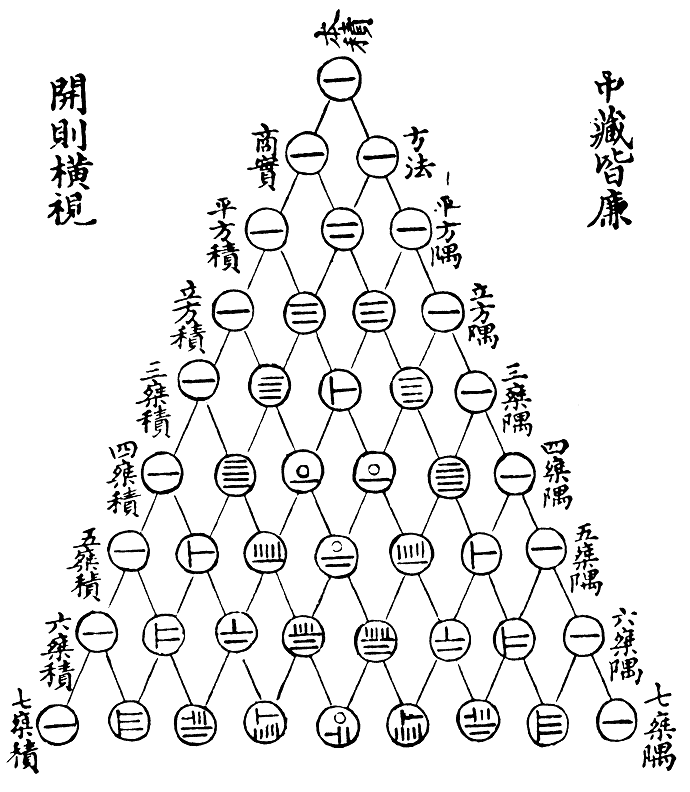
2.4 Exercises
Exercise 2.1 (Number of events in a finite sample space)
- Consider a sample space with three possible outcomes. That is, \[ \Omega = \{ a, b, c \}. \] List all of the possible events. How many are there?
- Argue that for any sample space \(\Omega\) with a finite number of outcomes, the number of events is \(2^{|\Omega|}\).
Exercise 2.2 (Round-robin tournament) In a round-robin tournament, every team plays every other team once. If there are \(n\) teams, how many total games are played? Express your answer as a binomial coefficient.
Exercise 2.3 (Trying keys at random) A friend asked you to house-sit while she is on vacation. She gave you a keychain with \(n\) keys, but she forgot to tell you which key was the one to her apartment. You decide to try keys at random until you find the right one.
- If you discard keys that do not work, what is the probability that you will open her apartment on the \(k\)th try?
- What is the probability if you do not discard keys that do not work?
Exercise 2.4 (Each side comes up exactly once) The frequentist interpretation of probability says that if we were to toss a fair die many, many times, then each of the six sides should come up about \(1/6\) of the time.
Suppose we toss a fair die six times. Is it likely that each side will come up exactly once? Calculate the probability.
Exercise 2.5 (Elevator stops) You enter an elevator on the first floor of a 15-floor hotel with 3 strangers. You are staying on the 10th floor. If the other 3 people in the elevator are equally likely to be staying on floors 2 to 15, independently of one another, what is…
- the probability that the elevator will stop three times before arriving at your floor? (Ugh!)
- the probability that the elevator will not stop at all before arriving at your floor? (Yay!)
Exercise 2.6 (Probability of a Yarborough) In the card game bridge, each player is dealt a hand of 13 cards from a shuffled deck of 52 cards. In the 19th century, the Earl of Yarborough was known to offer 1000-to-1 odds that a bridge hand would contain at least one card that was ten or higher. As a result, a hand that has no cards higher than nine is called a Yarborough. What is the probability of a Yarborough? Was the Earl’s bet favorable or unfavorable to him?
Exercise 2.7 (Rooks on a chessboard) In chess, a rook is able to capture any piece that is in the same row or column. If \(8\) rooks are placed at random on a standard chessboard (\(8\times 8\)), what is the probability that no rook can capture any other?
Exercise 2.8 (Hash collisions) In computer science, a hash table is a data structure for storing information so that it can be accessed quickly. A hash table contains \(n\) “addresses” where data can be stored. For simplicity, we will assume that these addresses are labeled \(1, 2, \dots, n\).
For example, consider an American company that maintains employee records. Each employee is uniquely identified by their Social Security Number (SSN) \(s\), which is then “hashed” by a hash function \(h(s)\), which returns a number \(1, 2, \dots, n\). The data for that employee is then stored at that address. A hash function always returns the same address for a given SSN \(s\), but over many SSNs, a hash function behaves like a random number generator, with each number \(1, 2, \dots, n\) equally likely.
One problem with hash tables is the potential for a hash collision: when two employees have different SSNs \(s_1\) and \(s_2\) that are hashed to the same address, \(h(s_1) = h(s_2)\). Since we can only store one employee’s records at that address, alternative approaches are required.
For a hash table with \(k\) records and \(n\) addresses, calculate the probability of a hash collision, assuming \(k \leq n\).
Exercise 2.9 (Probability of a four-of-a-kind) In poker, what is the probability of a four-of-a-kind (four cards of the same rank, plus one additional card)? Calculate this probability in two ways:
- counting hands where order matters
- counting hands where order does not matter
Exercise 2.10 (Probability of \(k\) heads in \(n\) tosses) Show that the probability of observing exactly \(k\) heads in \(n\) tosses of a fair coin is \[ P(\text{exactly } k \text{ heads in } n \text{ flips}) = \frac{{n \choose k}}{2^n}. \]
Exercise 2.11 (Combinatorics of DNA) The evolutionary biologist Richard Dawkins (1998) opened his book Unweaving the Rainbow with the following poetic passage:
We are going to die, and that makes us the lucky ones. Most people are never going to die because they are never going to be born. The potential people who could have been here in my place but who will in fact never see the light of day outnumber the sand grains of Arabia. Certainly those unborn ghosts include greater poets than Keats, greater scientists than Newton. We know this because the set of possible people allowed by our DNA so massively outnumbers the set of actual people. In the teeth of these stupefying odds it is you and I, in our ordinariness, that are here.
In this exercise, we will determine these “stupefying odds” by counting the number of possible people. The human genome consists of approximately \(3.1 \times 10^9\) bases. Each base is one of four molecules: adenine (A), thymine (T), guanine (G), or cytosine (C). How many possible genomes are there?
Exercise 2.12 (Combinatorics of proteins) DNA is turned into protein via the central dogma of biology. It is first transcribed into messenger RNA, then translated into amino acids via the process shown in Figure 2.9. Amino acids are the building blocks of all proteins.
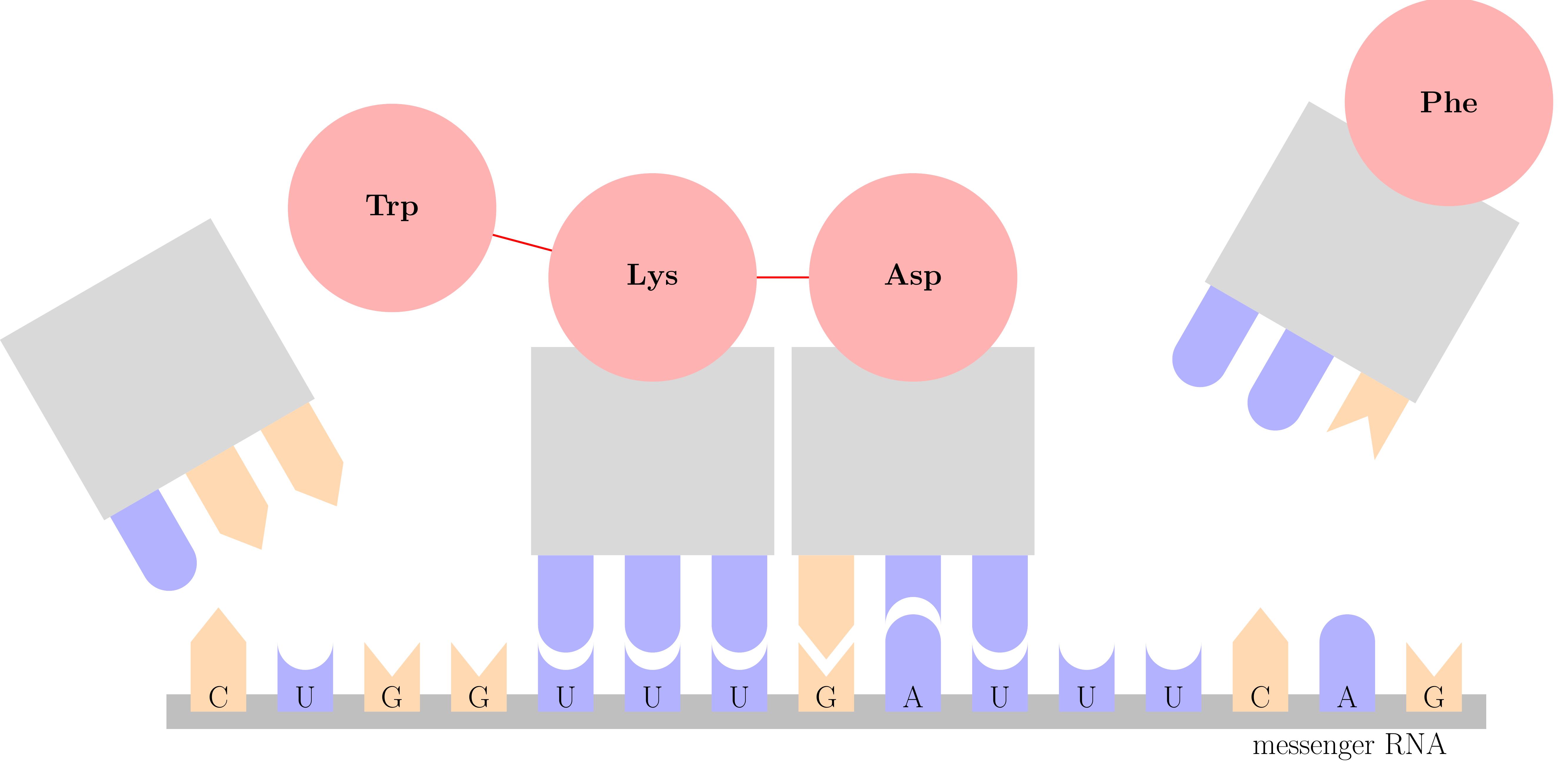
Notice that it takes three bases to code for each amino acid. There are 20 different amino acids in total. The order of the bases matters, so UGG codes for tryptophan, while GGU would code for glycine.
- Using counting, explain why three bases are needed to code for amino acids. (Why would two bases not be enough?)
- Before biologists discovered translation, the physicist George Gamow suggested that the same three bases, in any order, code for the same amino acid. That is, under Gamow’s proposal,
UGG,GGU, andGUGwould all code for the same amino acid. How many distinct amino acids could be represented under Gamow’s proposal?
In some sense, Gamow’s solution was more mathematically elegant than nature’s solution. For a survey of this and other proposals for the genetic code, see Hayes (1998).
Exercise 2.13 (Galileo’s problem) The Grand Duke of Tuscany observed that rolling three fair six-sided dice resulted in a sum of 10 more often than a sum of 9. Since he counted exactly six ways to obtain each sum, he was puzzled. He consulted one of the finest minds in Tuscany - the astronomer and physicist Galileo Galilei - who provided a satisfactory explanation. Your task is to reconstruct Galileo’s argument.
- If the order in which the three numbers are rolled does not matter, how many possible outcomes are there? How many of these yield a sum of 9? How many yield a sum of 10?
- If the order in which the three numbers are rolled does matter, how many possible outcomes are there? How many of these yield a sum of 9? How many yield a sum of 10?
- What is the probability of rolling three numbers that sum to 9? What about the probability of rolling three numbers that sum to 10? Which of the previous parts was most useful in answering these questions? Why?
- In words, explain the flaw in the Duke’s reasoning.
Exercise 2.14 (Number of integer solutions) How many different integer solutions \((x_1, x_2, \dots, x_k)\) are there to the equation \[ x_1 + x_2 + \dots + x_k = n \] if
- the \(x_i\)s are all non-negative? (Hint: Which of the four cases of Table 2.1 does this correspond to?)
- the \(x_i\)s are all positive? Assume for this part that \(k \leq n\) so that there is at least one solution. (Hint: If the \(x_i\)s are positive, then you can start by assigning \(1\) to each \(x_i\), and then the problem reduces to part a above.)
Exercise 2.15 (Number of bootstrap samples) In statistics, it is useful to generate new data sets with similar properties to an original data set. For example, suppose we have data \(w_1, w_2, \dots, w_n\) on \(n\) subjects, representing their weights (in kilograms). For simplicity, we will assume that \(w_1, w_2, \dots, w_n\) are all distinct.
One popular way to generate a new data set with similar properties to the original data set is the bootstrap. (Efron 1979) In the bootstrap, we sample with replacement from the original data. So for example, if \(n=3\) and \(w_1=62\), \(w_2=75\), and \(w_3=69\), then possible bootstrap data sets include
- \(w_1^* = 69, w_2^* = 62, w_3^* = 69\)
- \(w_1^* = 69, w_2^* = 75, w_3^* = 62\)
- \(w_1^* = 75, w_2^* = 75, w_3^* = 75\)
- \(w_1^* = 69, w_2^* = 69, w_3^* = 62\)
Notice that the bootstrap always generates a new data set that is the same size as the original data set, but values may be repeated.
- What is the probability that the bootstrap generates a data set that consists of the same \(n\) values as the original data set (except possibly in a different order)?
- In statistics, the order of the data is often arbitrary, so the bootstrap data sets 1 and 4 above are essentially the same, since both consist of two \(69\)s and one \(62\). How many distinct bootstrap samples are there, if we ignore order? Are these bootstrap samples equally likely?
Exercise 2.16 (Ordering the four ways of counting) Table 2.1 shows the four ways of interpreting the question, “How many ways are there to pick \(k\) items from \(n\) (unique) items?” Order these values from largest to smallest, and prove your answer.
Exercise 2.17 (Problem of points, general case) Recall the problem of points (Example 1.10). Now suppose the players are playing to \(n\) points, but the game is interrupted when Player A has \(a\) points and Player B has \(b\) points. Give a general formula for a fair way to divide the stakes in terms of \(a\), \(b\), and \(n\). Your answer should involve sums of binomial coefficients.
Remark: Pascal invented his famous triangle to calculate these binomial coefficients efficiently.
2.4.1 Combinatorial Identities
Exercise 2.18 (Choosing the complement) Prove the following identity in two ways: by algebra and by counting in two ways.
\[ {{n}\choose{k}} = {{n}\choose{n-k}}. \tag{2.6}\]
Exercise 2.19 (Vandermonde’s identity) Prove Vandermonde’s identity by counting in two ways.
\[ {{m+n}\choose{k}} = \sum_{j=0}^k {{m}\choose{j}} {{n}\choose{k-j}} . \tag{2.7}\]
We will use this identity later in Example 10.4.
Exercise 2.20 (Hockey stick identity) Prove the hockey stick identity: \[ \sum_{m=r}^{n} \binom{m}{r} = \binom{n+1}{r+1}. \] Try doing this in several ways:
- by counting in two ways (Hint: Consider choosing \(r+1\) numbers from the set \(\{ 1, 2, \dots, n+1 \}\). Now, what if you first choose the largest number and then choose the remaining \(r\) numbers?)
- by repeatedly applying Pascal’s identity (Proposition 2.6)
If you sketch the above identity on Pascal’s triangle, you will see why it is called the “hockey stick identity.”
We will use this identity later in Example 31.1.
Exercise 2.21 (Binomial theorem) Give a combinatorial argument for the binomial theorem: \[ (x + y)^n = \sum_{k=0}^n {n \choose k} x^k y^{n-k}. \]
Hint: Expand the left-hand side, and argue that the number of terms that reduce to \(x^k y^{n-k}\) is \({n \choose k}\).
Exercise 2.22 (Sum of first \(n\) positive integers) According to a famous legend, the future mathematician Carl Friedrich Gauss was assigned by his schoolmaster to add the numbers from \(1\) to \(100\). The schoolmaster was astonished when the young Gauss finished the task within a few minutes. Gauss realized that he could pair off the numbers—the smallest with the largest, the second-smallest with the second-largest, and so on—so that each pair had a sum of \(101\): \[ \begin{align} 1 + 2 + \dots + 99 + 100 &= (\underbrace{1 + 100}_{101}) + (\underbrace{2 + 99}_{101}) + \dots + (\underbrace{50 + 51}_{101}) \\ &= 50 \cdot 101 \\ &= 5050. \end{align} \] Hayes (2006) provides the history of this legend.
Derive a general formula for the sum of the first \(n\) positive integers. A simple approach is to count the number of games in a round-robin tournament (Exercise 2.2) in two ways, thereby showing that \[ 1 + 2 + \dots + n = \sum_{k=1}^n k = \binom{n+1}{2} = \frac{(n+1)n}{2}. \]
This identity is also useful in probability. We will use it later in Exercise 9.6.
Exercise 2.23 (Picking committees with officers) Prove the following identities by counting in two ways.
- \(\displaystyle \sum_{k=0}^n \binom{n}{k} = 2^n\)
- \(\displaystyle \sum_{k=1}^n k \binom{n}{k} = n 2^{n-1}\)
- \(\displaystyle \sum_{k=1}^n k^2 \binom{n}{k} = n(n+1) 2^{n-2}\)
- \(\displaystyle \sum_{k=1}^n k^3 \binom{n}{k} = n^2(n+3) 2^{n-3}\)
(Hint: Count the number of committees with 0, 1, 2, and 3 officers, respectively, where the same person can occupy the same office.)
